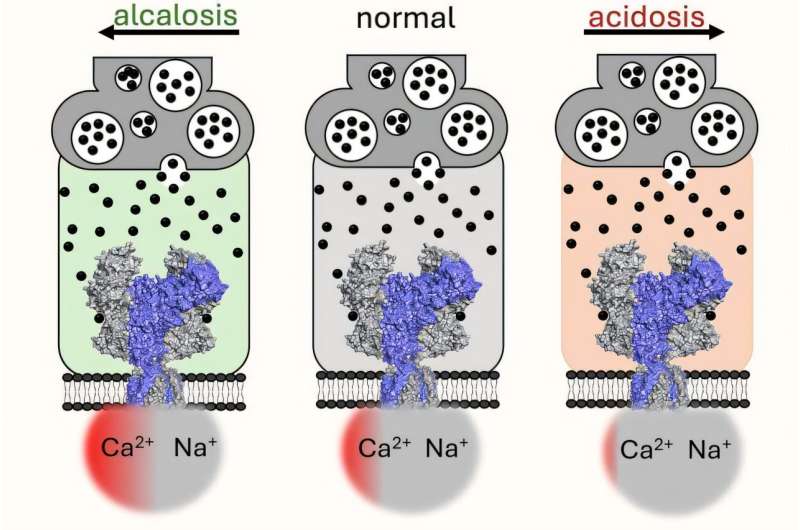
News
November 07, 2025
Textbook view of NMDA receptor calcium signals upended by new findings
Drugs that act on NMDA (N-methyl-D-aspartate) receptors, which are essential for learning, memory and moment-by-moment consciousness, are key for treating neuropsychiatric disorders. These drugs were developed based on the assumption that the proportion of calcium in the current produced by these receptors remains constant. That assumption turns out to be false, according to University at Buffalo research published last month in the Proceedings of the National Academy of Sciences.
**Textbook view of NMDA receptor calcium signals upended by new findings**
For decades, the understanding of how certain vital brain receptors function has been based on a seemingly solid foundation. Now, that foundation is being challenged, thanks to groundbreaking research from the University at Buffalo. Their findings, published in the prestigious Proceedings of the National Academy of Sciences last month, cast doubt on a long-held assumption about NMDA (N-methyl-D-aspartate) receptors.
NMDA receptors are crucial players in the brain. They are essential for learning, memory formation, and even our moment-to-moment awareness. Because of their central role, drugs that target these receptors are important tools in treating a range of neuropsychiatric disorders. Scientists have been working on developing and refining these medications for years, guided by a particular model of how NMDA receptors work.
The conventional wisdom has been that the proportion of calcium within the electrical current produced by these receptors remains constant. Calcium ions flowing through NMDA receptors are a critical part of the signaling process. It was believed that regardless of the activity level or the specific conditions, the relative amount of calcium entering the cell through these receptors stayed the same. This assumption has been fundamental to understanding how these receptors influence brain function and how drugs interact with them.
However, the University at Buffalo research indicates that this isn't the case. The study demonstrates that the proportion of calcium within the NMDA receptor current is not fixed, but rather can vary. This discovery has significant implications for our understanding of how NMDA receptors function and how drugs targeting them affect the brain.
The implications of this finding are far-reaching. It suggests that existing drugs targeting NMDA receptors may be working through mechanisms that are not fully understood. Furthermore, it opens up new avenues for research into developing more effective and targeted treatments for neuropsychiatric disorders. By challenging this fundamental assumption, the University at Buffalo research is paving the way for a more nuanced and accurate understanding of NMDA receptor function, which could ultimately lead to better therapies for a range of debilitating conditions. The scientific community will now need to re-evaluate existing models and consider how this new information changes our understanding of brain function and drug development.
For decades, the understanding of how certain vital brain receptors function has been based on a seemingly solid foundation. Now, that foundation is being challenged, thanks to groundbreaking research from the University at Buffalo. Their findings, published in the prestigious Proceedings of the National Academy of Sciences last month, cast doubt on a long-held assumption about NMDA (N-methyl-D-aspartate) receptors.
NMDA receptors are crucial players in the brain. They are essential for learning, memory formation, and even our moment-to-moment awareness. Because of their central role, drugs that target these receptors are important tools in treating a range of neuropsychiatric disorders. Scientists have been working on developing and refining these medications for years, guided by a particular model of how NMDA receptors work.
The conventional wisdom has been that the proportion of calcium within the electrical current produced by these receptors remains constant. Calcium ions flowing through NMDA receptors are a critical part of the signaling process. It was believed that regardless of the activity level or the specific conditions, the relative amount of calcium entering the cell through these receptors stayed the same. This assumption has been fundamental to understanding how these receptors influence brain function and how drugs interact with them.
However, the University at Buffalo research indicates that this isn't the case. The study demonstrates that the proportion of calcium within the NMDA receptor current is not fixed, but rather can vary. This discovery has significant implications for our understanding of how NMDA receptors function and how drugs targeting them affect the brain.
The implications of this finding are far-reaching. It suggests that existing drugs targeting NMDA receptors may be working through mechanisms that are not fully understood. Furthermore, it opens up new avenues for research into developing more effective and targeted treatments for neuropsychiatric disorders. By challenging this fundamental assumption, the University at Buffalo research is paving the way for a more nuanced and accurate understanding of NMDA receptor function, which could ultimately lead to better therapies for a range of debilitating conditions. The scientific community will now need to re-evaluate existing models and consider how this new information changes our understanding of brain function and drug development.
Category:
Technology